In some of my prior projects, to get between the dash and the frunk area, I ran a few wires around the door. While fairly easy, it’s only suitable for a few thin wires and is far from ideal. If you are installing the amp inside the dash, then a new power lead needs to be routed from the fuse box to the dash. If you’re installing the amp in the frunk, then you’ll need to run the line-level inputs and the sub-woofer speaker wires from the dash area to the frunk.
Fortunately, Tesla provides a nice rubber grommet on the passenger side of the firewall that is perfect for this. The bad news is it is really hard to access the grommet on either side. We’ve worked out an approach that minimizes the disassembly effort. In my specific installation with the amp in the dash, I only need to run one thick power lead. I used the 8 gauge power lead included in the NVX installation kit. It’s a rather thick wire, but it’s well insulated. The wire even includes a secondary mesh jacket over the portion we’ll leave in the frunk. While these instructions are specific to my installation, they can be adapted to having the amp in the frunk or other projects.
We need to make a hole in the grommet to pass our wire through. While this took me about 3 hours to figure this out and document, I think it would take only 20-30 minutes to perform this part with these instructions. For me, it was the hardest part of the entire project!
- In the cabin, if the front passenger plastic sill plate is still attached, remove it by lifting up on the rear portion of the sill and snapping it out.
- In the frunk, remove the top cover near the windshield. Remove the passenger side rubber bumper (it unscrews counterclockwise). Then lift out the passenger side cover.
- Remove the air filter from the Front Plastic Assembly (FPA).
- Now we’ll make it possible to access the grommet from the frunk side. Fortunately, this spot is only a single firewall layer to deal with, as other areas have two firewalls with an inch of insulation between them.
- There is a substantial rubber cover that goes over the top of the shock absorber and covers part of the FPA. This rubber cover is difficult to remove, so we’ll work around it. Peel the portion of the rubber cover that is on top of the FPA, you’ll see a black plastic clip. Remove the clip by using a thin screwdriver to pry up the center snap, and the plastic fastener will release and can be easily removed. There are two more similar plastic fasteners that also need to be removed (one is shown in the image above). Be careful not to drop these into the bowels as I did. You’ll never recover it. There is one more fastener under the driver’s side cover, but it’s not important to release this one as we’re not removing the FPA.
- Now peel back the rubber cover enough to pull up the FPA on top and push the rubber cover under the FPA.
- Pull up on the FPA (maybe 3-4” at most) near the rubber cover. With a flashlight, at one angle you should be able to see the rubber grommet that is about 18” down from the windshield and about 5” from the outside edge of the car. It’s not important if you can’t see it, as all the work will be done by touch.
- Reach in under the FPA and find the grommet by feel so you get comfortable as to its location.
- You’ll need a few tools to make a hole in the rubber grommet. These must be under 4” long to fit into the area. I used a small screwdriver and a stubby #2 Phillips screwdriver. To prevent dropping a tool I drilled a small hole in the handle of each screwdriver and attached a 6 ft length of 22 Gauge stranded wire. Any thin wire or string will work. The 12V battery is below the grommet, so you don’t want a metal tool getting loose and rattling around on top of the 12V battery!
- Starting with the small screwdriver in hand, locate the rubber grommet by feel. Poke a hole in the center of the grommet. Remove the tool and switch to the Phillips screwdriver. Enlarge the hole with the Phillips screwdriver.
- Take the end of the power cable you’re going to use. I soldered a 6” length of 12-14 Gauge solid wire leftover from a house wiring project. I then used some heat shrink tubing over the junction. You want a gradual increase in the diameter so it can be pulled through. It doesn’t have to look good, as we’ll chop it off later on.
- With the solid wire in hand on the frunk side, poke the wire through the grommet as far as it will go. You’ll likely find you can’t push any more than just the solid wire. Leave plenty of slack in the attached power wire.
- Move to the passenger floor and with a bright light, you should see the solid wire sticking out of the grommet. Grab this wire and pull it to get the power wire through the hole. This sounds easier than it is. You’ll be in a very awkward position and find there is almost no room to get your hand there. I used some long-nose pliers to bend the 14 gauge wire and make a hook I could grab. As you pull, the power lead will come through. Keep pulling until you have enough wire. With the NVX installation kit, I pulled until the braided portion was close to the firewall. I’m guessing about 14 feet of wire pulled through. You may need to switch back to the frunk several times to keep the wire from hanging up. Even better, have someone help feed the wire in the frunk while you pull the wire under the dash and tell you when to stop.
Now we want to feed the speaker wire and the power wire from the passenger side to the driver’s side where we’ll mount the amp. While the entire dash could be removed (a huge project), Tesla was nice enough to provide an empty structural tube that runs the length of the dash. We’ll route the wires through the tube and save a lot of effort and time.
- Remove the black plastic side panels on each side of the dash. These are held in place with 3 snaps. I found starting near the bottom with a plastic tool works to detach each panel. A FOB antenna is mounted on each side panel and should be disconnected to get it out of the way. There is a tiny latch that can be depressed with a small screwdriver to release the connector.
- With a light, you should see the steel tube we use to route the wires from the passenger side to the driver’s side.
- Back at the passenger side; feed the wires up between the dash and the side of the car. There is a small slot that can be used.
- Using the fish tape, feed the tape through the tube from the driver’s side.
- Connect the 14 gauge leader of the power wire to the fish tape and pull it through to the driver’s side.
- While the above image is helpful, I hadn’t yet routed the wire between the dash and the side of the car (step 3 above), so the dash side panel would never have gone back on as shown!
- Repeat the process to pull the speaker wire to the driver’s side as well.
- Do not pull the wires tight – leave an inch or so of slack.
- Now we’re done with the passenger side cabin if you’re using the line-level outputs (described in more detail in the next section). If you don’t need access to the right-side speaker wires, you can button this up.
- Reattach the side dash panel. First, reconnect the FOB antenna connector and check that no wires will be pinched. I find starting at the top snap to work best and then the center and finally the bottom snap.
- Reattach the bottom sill panel. Angle the panel in the front and snap the snap in the front first. Then push from the back and snap the rest of the panel in place.
Continued in Part 3: Amplifier Installation…
or return to Part 1: Installing the Sub-woofer and Wiring
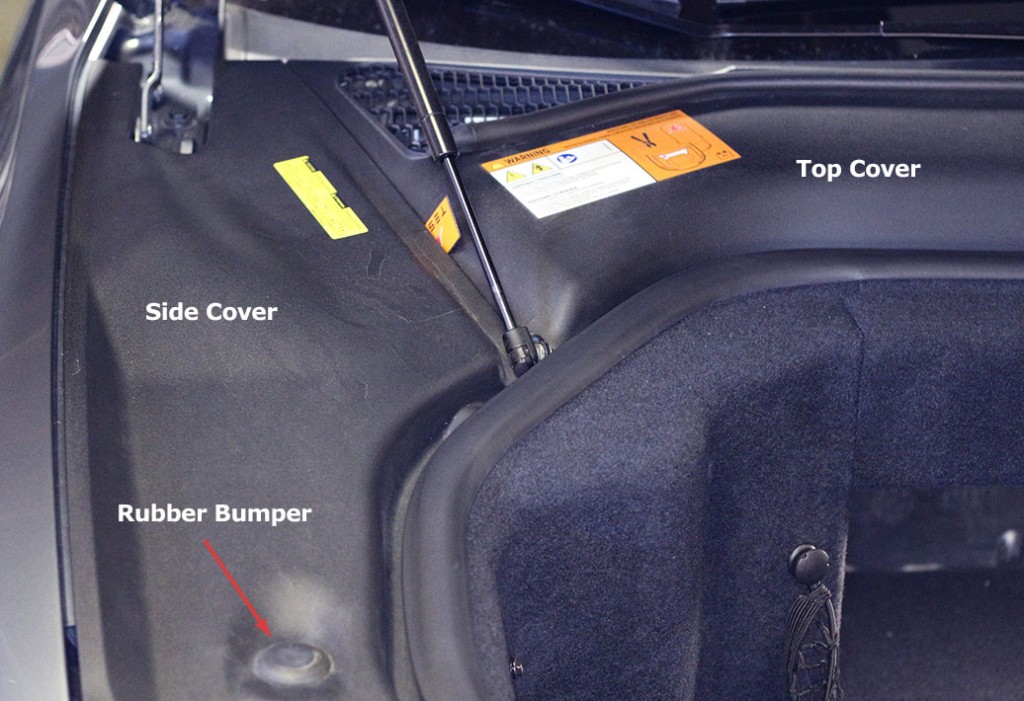
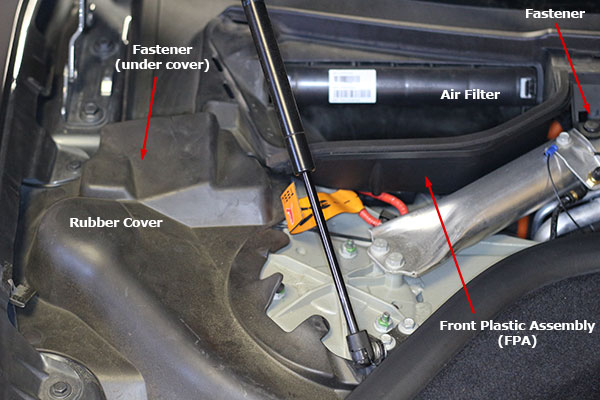
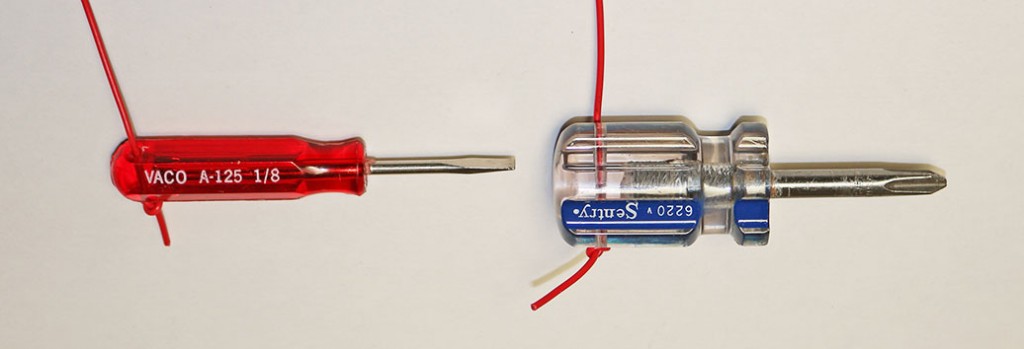
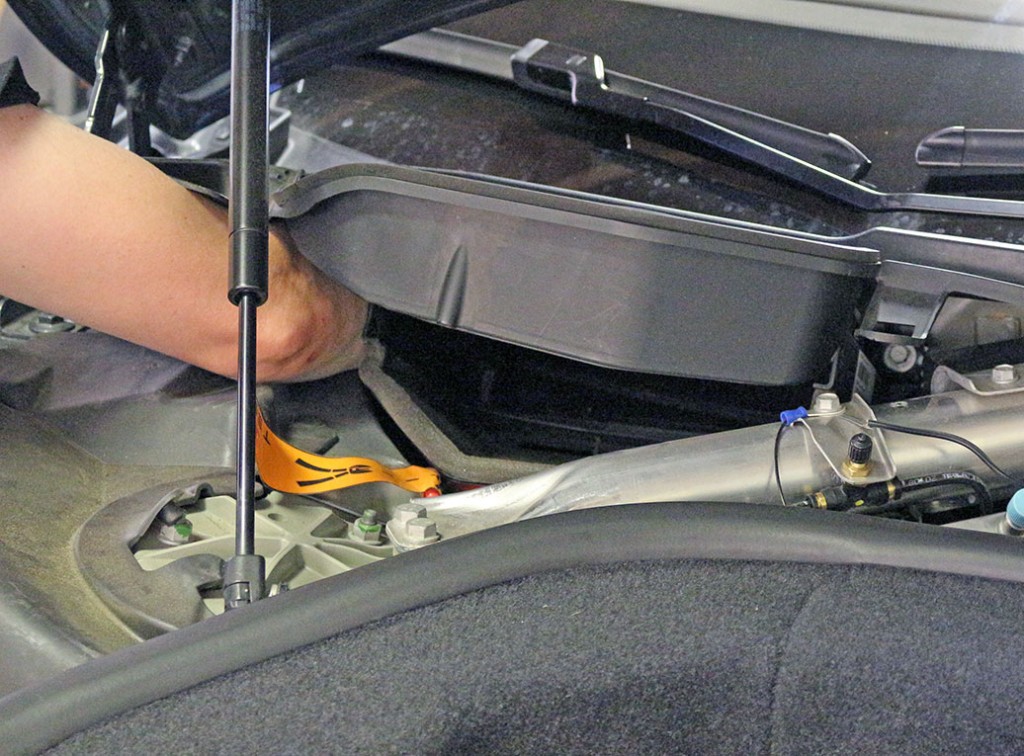

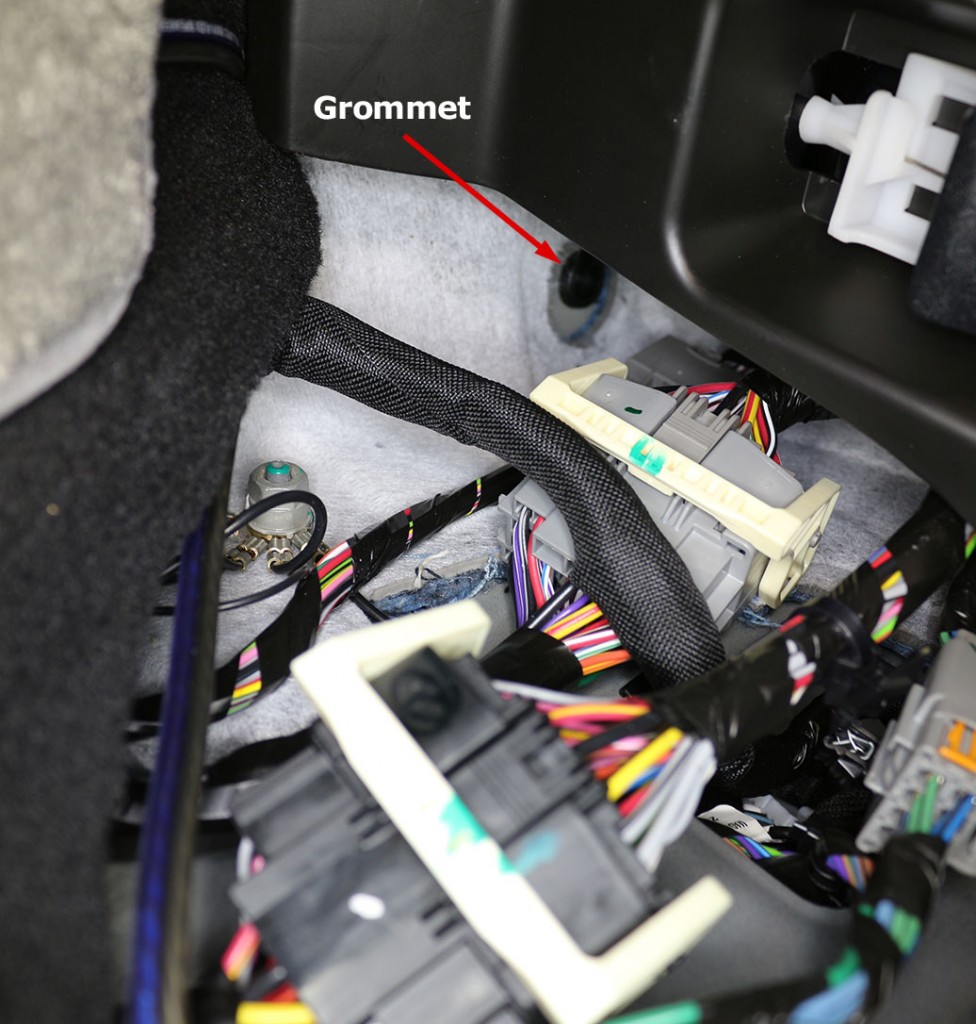
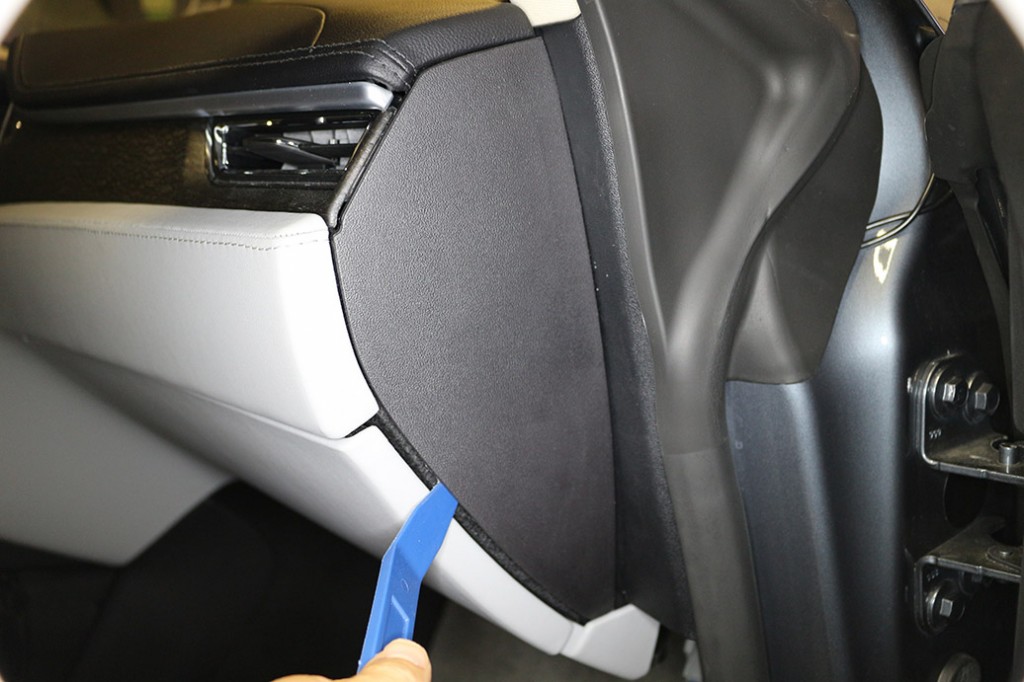
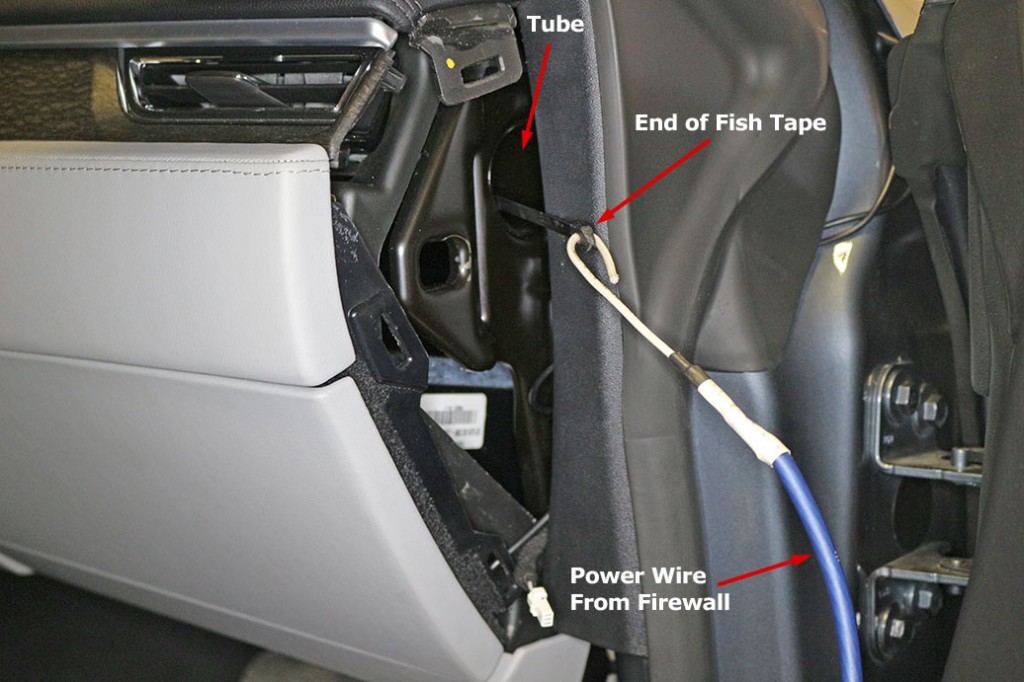
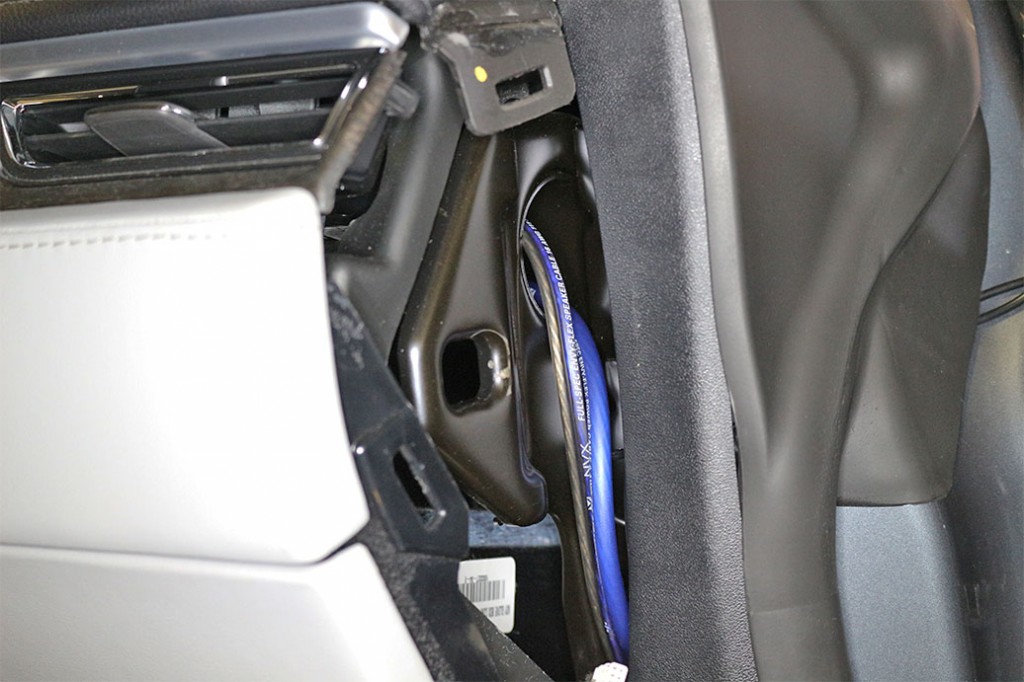
10 comments
Hi guys I’m considering adding an aftermarket amplifier to a future model s. I like that this project does not tap into the battery and instead the fuse box. I have read mixed articles where some people have future issues with the battery and/or DC-DC converter when doing so. Does anyone know if the fuse box is connected to the DC-DC converter? And has anyone had any issues long term by adding accessories to the fuse panel?
The fuse box is connected to both the battery and DC-DC inverter. It’s best to go through the fuse box. Be aware you can’t pull massive amounts of power. Ideally, 15 amps should be your goal, but 30 amps seems doable. I’d not go beyond that – which limits your amp choices. Go with Class-D amp, as these are the most power-efficient. I’ve had zero issues with the 300W amp I installed with this project. This was in a 2013 S, back when the DC-DC inverter was not as well-protected as newer models.
Install is nearly complete:
Front camera from driver view
https://www.dropbox.com/s/jegfhmaeaav0j9p/driverviewfront.jpg?dl=0
Front camera from passenger view
https://www.dropbox.com/s/1vpg6e9pw2rlsrn/passengerviewfront.jpg?dl=0
Rear camera is hidden from view 🙂
https://www.dropbox.com/s/opvlkdsacd29mvw/viewrearcamerahidden.jpg?dl=0
Works well!
Here’s some pics of the drain hose from inside and outside the firewall. I’m going to drill another hole next to it with grommet and run a power line for misc future add-ons plus the dashcam power line thru the new hole and thru a stainless steel conduit up to the fuse box. I’ll 5200 the conduit into the firewall.
https://www.dropbox.com/s/rtndzuv7t22679v/insidedrainpic.jpg?dl=0
https://www.dropbox.com/s/19c3rjdftknf3e5/outsidedrainpic.jpg?dl=0
conduit planning on getting:
http://www.ebay.com/itm/5-16-I-D-STAINLESS-BRAIDED-AIRCRAFT-QUALITY-FLEXIBLE-ELECTRICAL-CONDUIT-18-/321539577816?pt=Motors_Aviation_Parts_Gear&hash=item4add4097d8&vxp=mtr
Thanks for the pictures. The space to work is so tight, I’m not sure how you’ll drill another hole – perhaps with a right-angle drill. I’m not sure the stainless steel conduit is needed, but it will make for a very nice looking installation. Good luck!
No it isn’t needed but having two wires inside leading directly to the #2 fuse box will be neat 🙂 might even help electrical noise. I have long 25″ drills will try from footwell side as soon as I get the conduit and appropriate grommet to know size of drill to use. Will post pics later.
That grommet in your car is used in my car by what appears to be a rubber drain hose possibly from the panoramic roof? So I’m likely going to drill another hole right next to it and put a grommet or possibly a conduit to run from the fuse box to inside under the glove box.
Drilled a hole in both the firewall and hatch (used same location as previously provided for his one). Put rubber grommets in both locations to prevent wear on cables. Turns out didn’t need the long drill to drill the 1/2″ hole in the firewall. Location is about 2 inches inboard of the existing grommet hole.
Firewall hole/grommet: https://www.dropbox.com/s/oozk535srljloiy/newholegrommet12v.jpg?dl=0
Hatch hole: https://www.dropbox.com/s/yvvjb78puegutti/hatchholelocation.jpg?dl=0
When running the Blackvue camera-to-camera cable from the hatch to the forward rear view mirror area, the hardest part was running the cable through the rubber hose that contains the existing cables from the body to hatch. Purchasing a wire lube even though I only used about one oz, was worth it. Picked up this from Lowes:
Wire Lube: https://www.dropbox.com/s/7iioyoibry5ybir/wirelube.jpg?dl=0
Turns out I didn’t use the stainless conduit. Not really needed as I used quality marine grade 12 Ga wire for the constant 12V feed and a grommet to protect against wear/shorting.
Were you able to fit a regular drill in that space to cut the 1/2″ grommet hole? Did you need any special tools or bits?
I have a sunroof, so I will not be able to use the factory grommet, but will have to drill a hole next to it, like you.
Thanks
It was a more than a year ago, but if memory serves me I didn’t use a drill as there isn’t enough space. It’s possible a right-angle drill with a short bit might work, but I didn’t need it. For me, I pulled out the existing grommet and make a hole and a slice (like a old keyhole) to slip the wire into the grommet. Once competed, I put silicone around the wire to seal it up. If drilling, you need to be very careful of the spot you choose to match up with the cabin side. There is a lot of stuff in that area and you don’t want to drill into something important! Good luck!